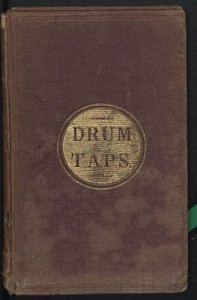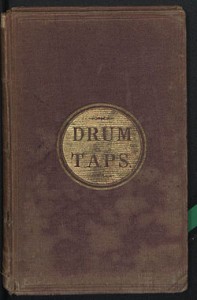
Whitman
Drum Taps
WALT WHITMAN II
Original by Chris Shepard | Link to Source
One of the most hauntingly beautiful of the Whitman “death poems” is from Drum Taps. It is at the heart of Vaughan Williams’ Dona Nobis Pacem. As I said at the Sing-In on Saturday, one reason I am so fascinated with RVW’s setting is that it is a “palimpsest” of sorts—there are architectural layers beneath its more prominent placement in the oratorio.
Although Dona Nobis Pacem was written in 1936, this movement was composed as a free-standing composition in 1914, at the onset of World War I. For some reason, I happen to be reading a couple different books that discuss WWI at the moment, and I’m especially aware of the idea that many villages sent virtually all of their men—of two generations—off to fight, often belonging to the same fighting unit. In this way, entire towns lost an unthinkable percentage of their men in the slaughter in the fields of Belgium. Vaughan Williams was clearly thinking of this as Germany was mobilizing for war in the mid 1930s, and as Mussolini was coming to power in Italy—that the unthinkable might, unthinkably, be repeated.
But there is another archeological layer to this composition: the poem itself. Whitman released this poem as part of his mighty Drum Taps, written throughout the war and published first in 1865, and then as part of a revised edition of Leaves of Grass (itself first published in 1855) that Whitman produced in 1867. Like World War I, the American Civil War resulted in extraordinary numbers of casualties, eclipsed in American warfare only by World War II. And again, so great was the need for soldiers that often two generations were lost, not just young men in their late teens and early twenties.
In this way, Vaughan Williams’ setting of Dirge for Two Veterans is a complex and rich tapestry of grief, encompassing the mourning of three wars and two major artists. Here is Whitman’s poem:
The last sunbeam
Lightly falls from the finished Sabbath,
On the pavement here, and there beyond it is looking
Down a new-made double grave
Lo, the moon ascending,
Up from the east the silvery round moon,
Beautiful over the house-tops, ghastly, phantom moon,
Immense and silent moon.
I see a sad procession,
And I hear the sound of coming full-key’d bugles,
All the channels of the city streets they’re flooding,
As with voices and with tears.
I hear the great drums pounding,
And the small drums steady whirring,
And every blow of the great convulsive drums,
Strikes me through and through.
For the son is brought with the father,
(In the foremost ranks of the fierce assault they fell,
Two veterans son and father dropt together,
And the double grave awaits them.)
Now nearer blow the bugles,
And the drums strike more convulsive,
And the daylight o’er the pavement quite has faded,
And the strong dead-march enwraps me.
In the eastern sky up-buoying,
The sorrowful vast phantom moves illumin’d,
(‘Tis some mother’s large transparent face,
In heaven brighter growing.)
O strong dead-march you please me!
O moon immense with your silvery face you soothe me!
O my soldiers twain! O my veterans passing to burial!
What I have I also give you.
The moon gives you light,
And the bugles and the drums give you music,
And my heart, O my soldiers, my veterans,
My heart gives you love.
Many composers have been drawn to this text, most notably RVW and his English compatriot Gustav Holst, who wrote a version of the same text for men’s choir, brass and drums in 1914. The first clip below is from Vaughan Williams’ Dona Nobis Pacem, conducted by Robert Shaw. Shaw had a special connection to the poetry of Whitman; it was he who commissioned and premiered one of the great twentieth-century choral works, Hindemith’s setting of When Lilacs Last in Dooryard Bloom’d. I had the great pleasure of seeing Shaw conduct the work at Yale only a couple years before his death—he was at the height of his powers, fully in command of the sprawling work. He brings a remarkable sensitivity to the text in this recording of the Dirge for Two Veterans with the Atlanta Symphony Orchestra and Chorus. (Editor’s note: the Atlanta recording has been removed and replaced by the following.)
For comparison, I include here the Holst version. Some people have suggested that Vaughan Williams set the Dirge in friendly competition with Holst; they are certainly very different works, with RVW’s near-Impressionist colors in contrast to the Holst’s more martial version. This clip is particularly special to me—speaking of mourning, it is conducted by the late Richard Hickox, whom I met on several occasions in Sydney when he was music director of the Australian Opera. He was always extremely kind to me, and I was as shocked as the rest of the musical world when he died at a very youthful 60 in November 2008, just as I was moving back to America. Though he was a strikingly versatile conductor (I especially remember an extraordinary production of Shostakovich’s Lady Macbeth of Mtsesnk that I saw him conduct), he had a special affinity for the English repertoire, as is clear from this recording.

